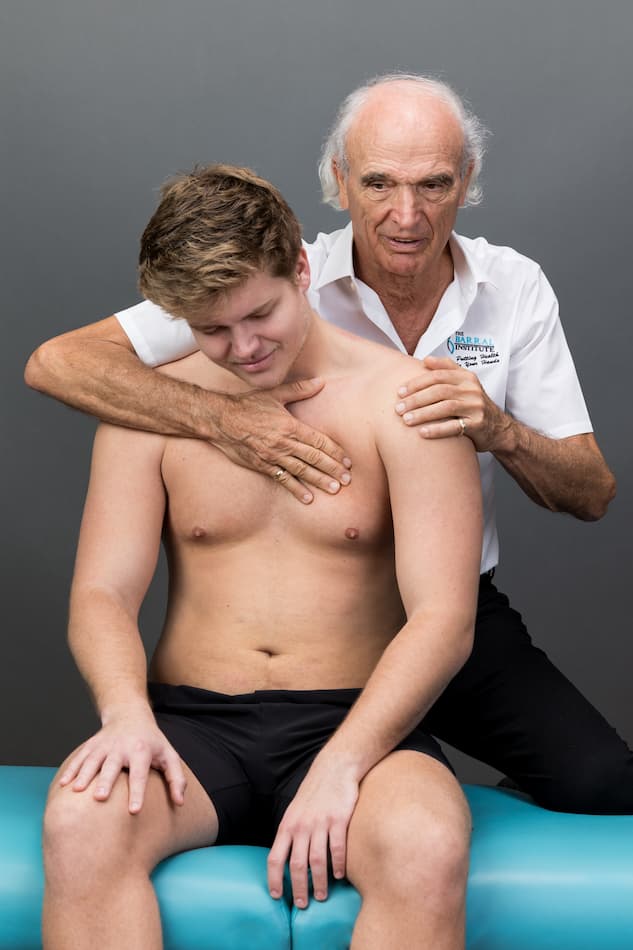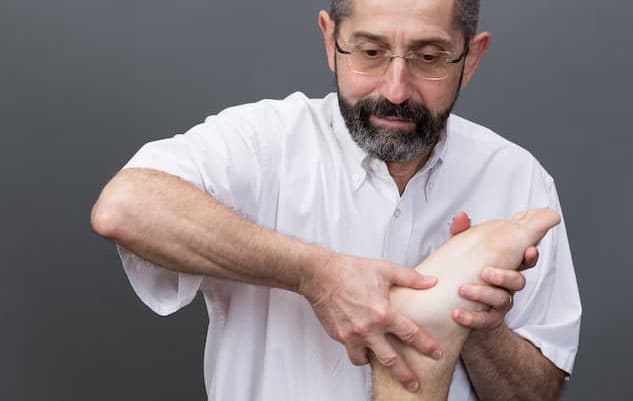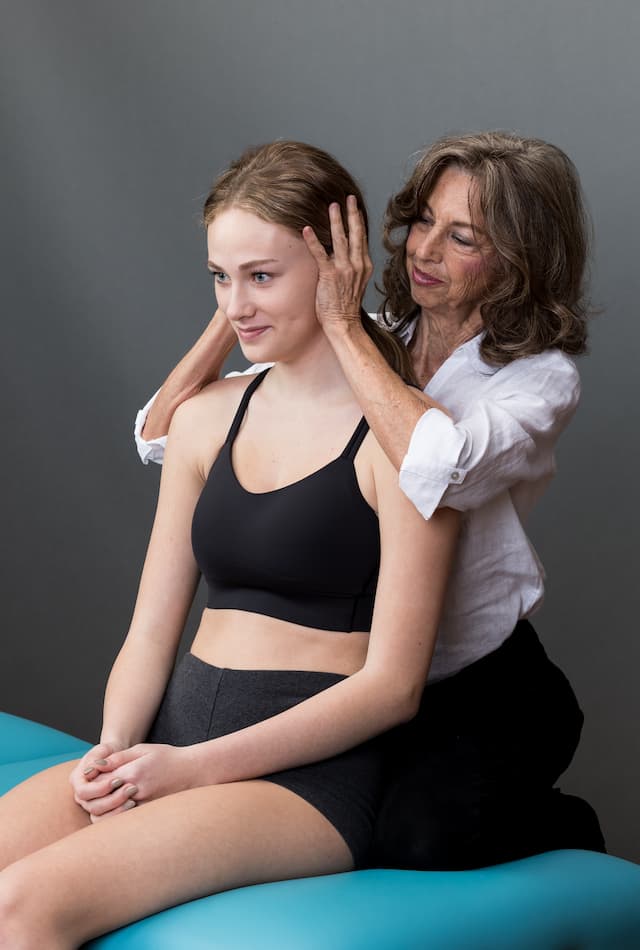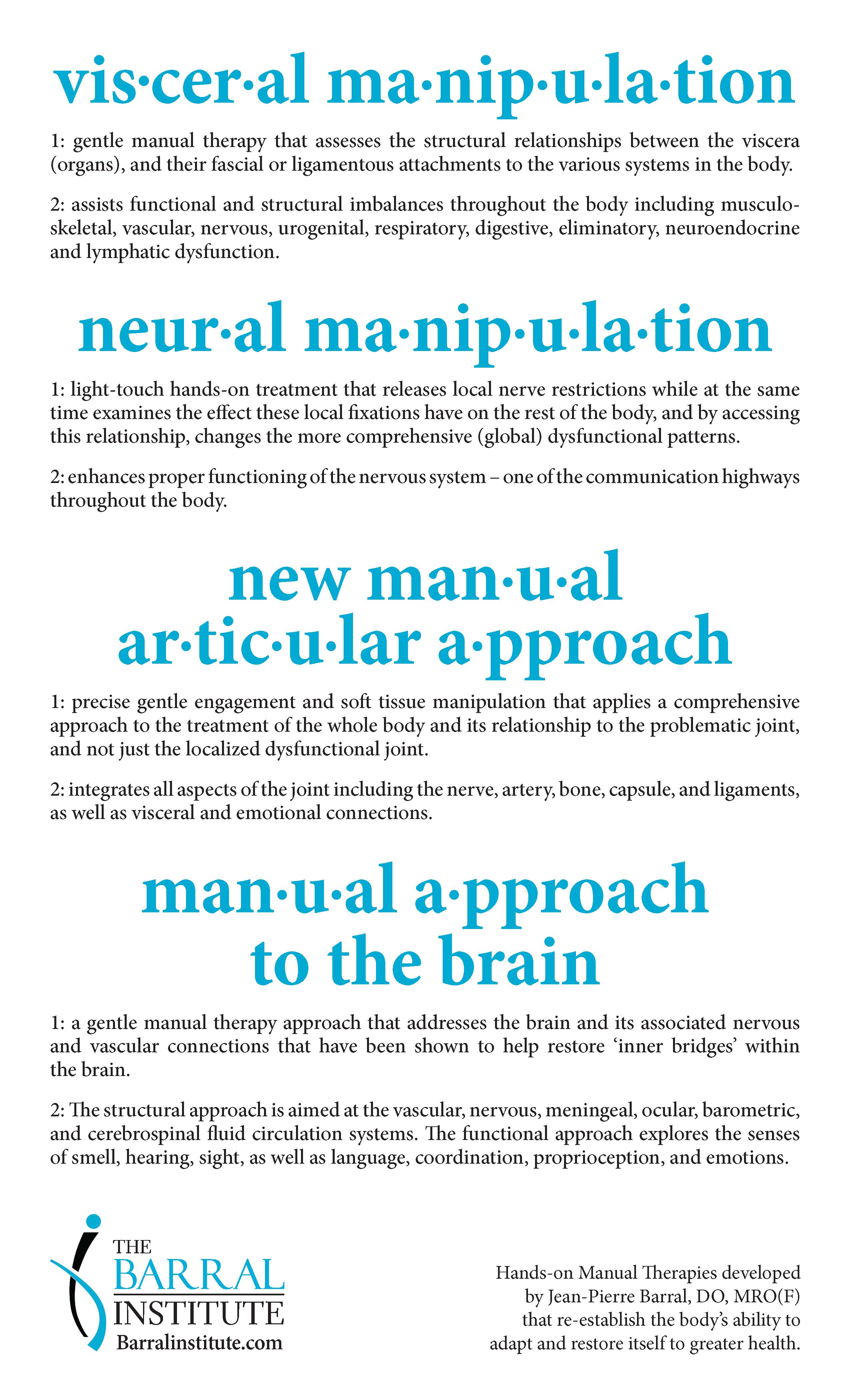
New Manual Articular Approach (NMAA) was developed through the clinical work of world-renowned French Osteopath and Physical Therapist Jean-Pierre Barral. French Osteopath Alain Croibier collaborated with Jean-Pierre Barral to develop NMAA. The BI courses are based on clinical techniques personally developed by Jean-Pierre Barral combined with Alain Croibier's scientific information. Barral developed NMAA in response to a gentler and more precise way to treat joints, especially when clients have significant pain. Joints have multiple components, including bones, cartilage, capsule, tendons, nerves, blood supply, and fluid. A symptom is only one piece of the puzzle and is not necessarily the most important element in that puzzle. The cause of a joint problem or pain may actually be located somewhere other than where the symptoms appear to be present. As with VM and NM methods, Barral uses listening techniques to assess the various components of the joint, and then work with the problematic components. The treatments are very gentle, incorporating the client's active movement, so as not to cause pain.
"Articular" refers to the joints of the body, which are critical points of interconnectivity between all other structures within the body. Joints receive and emit messages with other parts of the body, and are also connected to our emotions. New Manual Articular Approach is a manual therapy discipline that applies a comprehensive approach to the treatment of joints. It integrates all aspects of the joint including the nerve, artery, bone, capsule, and ligaments, as well as visceral and emotional connections. NMAA delves into the joints like never before. It examines the nerves of each joint, along with the arteries, meniscus, ligaments, capsule attachments and folds. It incorporates soft tissue mobilization of the associated bones, while looking at direct and indirect relationships between the bones of the body. The relationship between the viscera and the joints is not widely understood. NMAA shows how interconnected they are and that without addressing this visceral connection many joint issues may not fully resolve. The application of the gentle NMAA techniques improves the body's ability to heal and restore itself to optimal health.
Comparative studies found New Manual Articular Approach beneficial for people with various conditions such as:
Joint Pain
Limited Mobility
Joint Inflammation
Concussion & Traumatic Brain Injuries
Sprains
Tendinitis
Osteoarthrosis
Rotator Cuff Injuries
And more

NMAA is a soft, hands-on manual therapy. Underneath the pain or diagnosis is a compensatory pattern created in the body with the initial source of the dysfunction often being far from where the pain is felt. A skilled NMAA practitioner searches for this pattern and its source, evaluating the whole body and not just the problematic joint, and treats the related tissues. NMAA treatment is comprised of precise gentle engagement and soft tissue mobilization of the associated bones, while looking at direct and indirect relationships between the bones of the body. As the source of a problem is released, symptoms will start to decrease. Reaction and response time can vary with each Manual Articular Approach treatment.
Optimal health relies on a balanced relationship between the different systems of the body - such as the nerves/nervous system, organs (viscera) and their support tissues, bones, and other structures. An NMAA therapist identifies the source of disharmony in the body, as well as how and why it is impacting a joint where the patient is feeling symptoms. Through application of the gentle and specific NMAA techniques, the patient's body overall becomes less bound by dysfunctional patterns, releasing the affected joint and ultimately allowing the body to achieve a state of optimal health.

Frequently Asked Questions
What do the knee joint capsule, the hip joint capsule, the sacroiliac joint, the adductors of the hip, pectineus, the ovary, and the popliteal artery all have in common?
The obturator nerve. The obturator nerve, arising from L2-4, has both a sensory and motor component that can affect or be affected by the structures mentioned above. An inflamed ovary in pubescent girls can compress the obturator nerve that passes behind it, causing medial knee pain. This is often mistaken as pain from chondromalacia patella. Osteitis pubis is frequently diagnosed when the real perpetrator is compression of the obturator nerve somewhere along its length. A few items to consider in our assessment and differential assessment of the compression are viscera, a vertebral joint, a disc, or fascia.
Barral Manual Therapies look at the whole person. During the evaluation process, after restrictions or areas of immobility are identified, the related tissues released through precise treatment. The type of treatment depends upon where the restrictions are found. For example, if the liver is restricted, the treatment would include Visceral Manipulation. If the sciatic nerve is restricted, then Neural Manipulation would be a focus. And if the carotid artery is restricted, the treatment would involve Visceral Vascular Manipulation. This is why Jean-Pierre Barral has developed integrative manual therapies that work together to support the overall well-being of a person. Right shoulder pain and limited shoulder joint motion could be caused by liver restriction, or tension in the supraspinatus, infraspinatus and anterior shoulder capsule, or also tension in the right phrenic nerve to the respiratory diaphragm.
Visceral Manipulation is based on the specific placement of soft manual forces to encourage the normal mobility, tone and motion of the viscera and their connective tissues. These gentle manipulations can potentially improve the functioning of individual organs, the systems the organs function within, and the structural integrity of the entire body.
Harmony and health exist when motion is free and excursion is full - when motion is not labored, overexcited, depressed, or conflicting with neighboring structures and their mobility. Therapists using Visceral Manipulation assess the dynamic functional actions as well as the somatic structures that perform individual activities. They also evaluate the quality of the somatic structures and their functions in relation to an overall harmonious pattern, with motion serving as the gauge for determining quality.
Due to the delicate and often highly reactive nature of the visceral tissues, gentle force precisely directed reaps the greatest results. As with other methods of manipulation that affect the body deeply, Visceral Manipulation works only to assist the forces already at work. Because of that, trained therapists can be sure of benefiting the body rather than adding further injury or disorganization.
Learn the facts about Barral Institute Therapies. Discover our Manual Therapy Techniques and their benefits. This flyer is informative for your clients. Click here
This is not an exhaustive list of contraindications. We trust that each practitioner will study the work further to understand indications and contraindications in relation to working with clients with New Manual Articular Approach.
There are very few contraindications overall for New Manual Articular Approach. Pay attention to these signs: unexplained muscle atrophy, unexplained elevated temperature, sudden loss of balance or vertigo, Chiari malformation, unexplained memory loss or mental confusion, arterial hypertension, transient ischemic attacks, significant lymph ganglion swelling, acute ear-nose-throat infections, and acute inflammation of unknown etiology.

To find a Therapist, visit iahp.com

Definition Poster
Available for free downloading and printing!
- Excellent visual for your clinic,
- Share in your enewsletters for your clients.
- Flyer to pass out.
Share the jpg file on your Facebook page to help spread the word!
Become Certified
Ready to learn more about the process?
Get StartedContact Us
Have questions? Join newsletter?
Contact Us